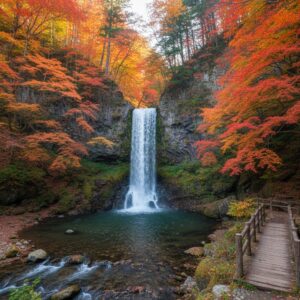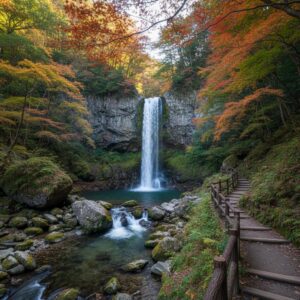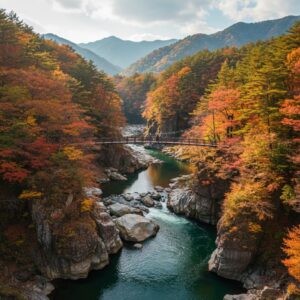In the sprawling urban tapestry of Osaka, where neon rivers flow and towers of glass pierce the clouds, it’s almost hard to imagine that a world of primal, untouched nature exists just a short train ride away. Yet, it does. Tucked into the northern hills, a mere thirty minutes from the city’s bustling heart, lies Minoo Park, a quasi-national park that feels like a portal to another era. This isn’t just a park; it’s a living, breathing sanctuary, a deep green canyon carved by the Minoo River, culminating in a spectacle that has captivated poets, artists, and weary city dwellers for centuries: the magnificent Minoo Waterfall. This journey is more than a simple hike; it’s an immersion, a sensory pilgrimage that recalibrates the soul. It’s a place where the rhythm of your footsteps syncs with the murmur of the stream, where the air grows cooler and cleaner with every step, and where the ultimate reward is a cascade of pure, thundering beauty. The trail, known as the Takimichi, isn’t a rugged backcountry trek but a gentle, paved path that invites everyone, from families with strollers to seasoned photographers, to witness its wonders. It’s a testament to Japan’s profound ability to preserve nature in close harmony with urban life, offering an escape that is both profoundly wild and wonderfully accessible. As you prepare to step onto this path, you’re not just leaving the city behind; you’re walking into a story painted in the vibrant hues of the seasons, a story that ends with the timeless roar of falling water.
To further explore the park’s natural wonders, you might be interested in learning about the wild monkeys of Minoh Park that inhabit this beautiful area.
The Journey Begins: Gateway to Nature’s Realm
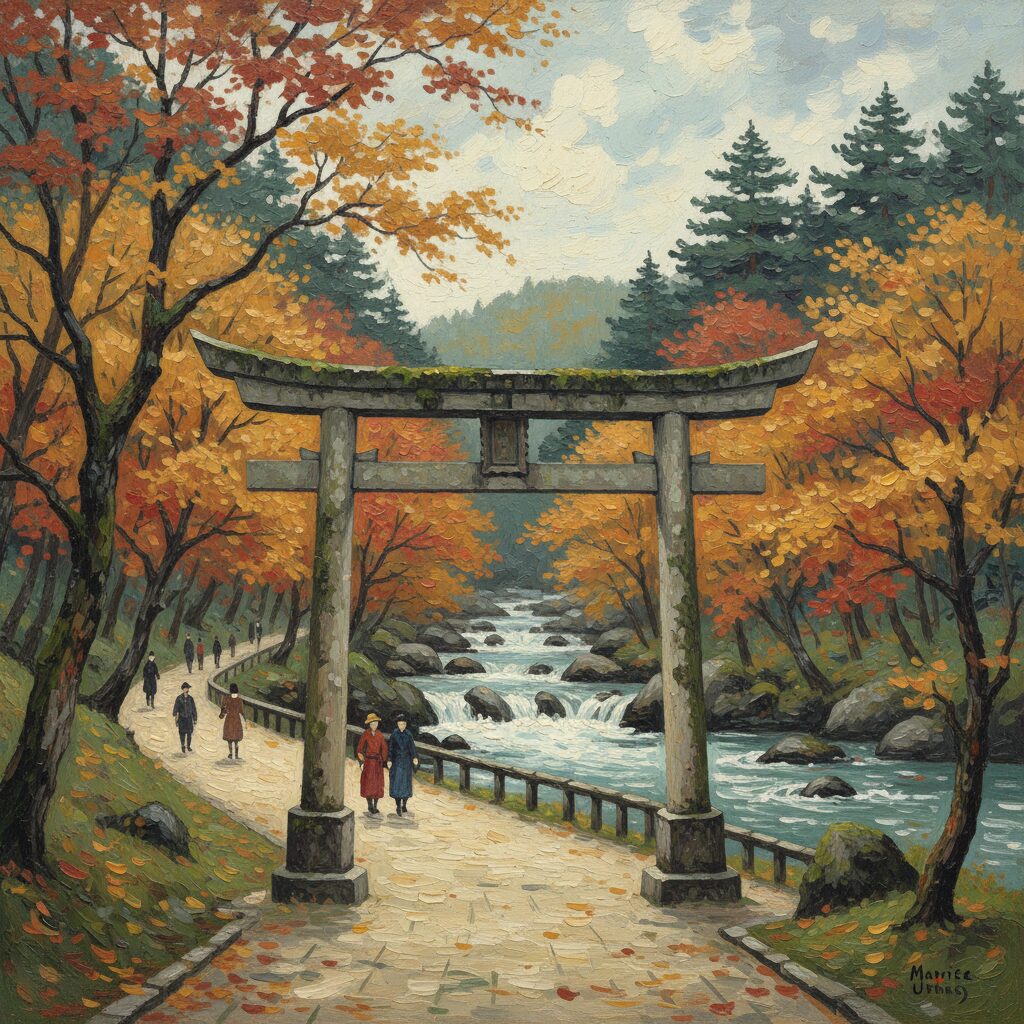
The journey to Minoo Park begins not at a rugged trailhead, but with the soft chime of a departing train at Hankyu Umeda Station. The ride itself offers a captivating transition. The dense blocks of Osaka slowly give way to quieter suburbs, buildings shrink, and suddenly, green hills fill the windows. When you disembark at the terminus, Hankyu Minoo Station, the transformation is complete. The air feels different here—fresher, imbued with the scent of damp earth and greenery. The station’s charming, almost nostalgic retro design provides a perfect prelude to the natural beauty ahead.
Nearby, the area around the station is a quaint, inviting town square. It serves as a gentle buffer between modern life and the ancient forest. Small shops and restaurants line the street, their awnings creating a cozy, village-like ambiance. This is your last chance to grab bottled water or a quick snack before starting your walk, but the true temptation lies in a unique local delicacy you’ll soon see and smell. The sweet, slightly oily aroma of freshly fried dough lingers in the air—a scent closely tied to this park. This is the home of momiji tempura, an iconic treat that introduces the distinctive cultural and culinary experience of Minoo Valley.
As you walk from the station, you’ll notice the park entrance isn’t marked by a grand gate but flows naturally from the town’s main road. The street seamlessly transforms into the forest path known as the Takimichi Trail. Sidewalk concrete gives way to smooth asphalt, and the sounds of traffic are replaced by the gentle, constant murmur of the Minoo River. You’re immediately wrapped in a canopy of trees. Sunlight filters through in dappled patterns, dancing on the path and water. This marks the true beginning—a gateway where the city’s frantic pace fades into the steady, timeless rhythm of the forest.
A Symphony of Sights and Sounds: The Takimichi Trail
The Takimichi Trail is the main thoroughfare of Minoo Park, a three-kilometer path that guides you from the edge of the town to the base of the waterfall. It is less of a hike and more of a scenic stroll—an impeccably maintained walkway running alongside the pristine Minoo River. This ease of access is its greatest appeal, making the valley’s profound beauty accessible to all. Walking this trail is a multi-sensory journey, gradually revealing the sights, sounds, and tastes that shape the character of Minoo.
The First Steps Along the Minoo River
From the start of the trail, the river accompanies you constantly, flowing to your left like a ribbon of clear water tumbling over smooth, mossy stones. Its gentle murmur serves as a soothing soundtrack, masking any distant outside noise. The path here is wide and mostly flat, perfect for a leisurely pace. Families with strollers, elderly couples hand-in-hand, and photographers stopping frequently, all enjoy the shifting light and shadow playing over the water.
Traditional stone lanterns line the path, while elegant vermilion bridges cross it, adding a touch of classic Japanese aesthetics to the natural surroundings. These bridges provide ideal vantage points to peer into the crystal-clear water, where small fish dart among the rocks. The flora is remarkably diverse—towering cedar and cypress trees form a dense canopy, and the forest floor is covered with ferns and native plants. In warmer months, the air buzzes with insect life and bird calls. The trail feels like a living corridor, welcoming you into the heart of a vibrant ecosystem.
A Culinary Detour: The Legendary Momiji Tempura
About a third of the way in, you’ll find a row of small open-air stalls, where vendors tend vats of bubbling oil. Here you can see and taste Minoo’s most famous and unique culinary creation: momiji tempura. These are not maple-flavored snacks but actual Japanese maple leaves deep-fried in a sweet batter. The idea is enchanting—a perfect symbol of the Japanese reverence for seasonal beauty.
Watching the process is fascinating. The leaves aren’t freshly picked; instead, they are harvested at peak autumn color, then preserved in salt barrels for over a year. This curing removes bitterness and softens the leaf. When ordered, the preserved leaf is carefully washed, coated in a simple, sweet sesame-flavored batter, then fried to a golden crisp. The snack is surprisingly delicious—light, crunchy, and subtly sweet, without a leafy or vegetal taste. The maple leaf’s shape remains perfectly intact, making the treat both beautiful and edible, a memorable souvenir from your visit.
Purchasing a small bag of warm momiji tempura to munch on as you continue the walk is an essential part of the Minoo experience. It connects you tangibly to the park, allowing you to literally taste the season. This tradition dates back over a thousand years, and indulging in it feels like taking part in a long, cherished history.
Mid-Trail Marvels: Temples and Treasures
The Takimichi Trail is not only a path through nature but also a route dotted with cultural and historical landmarks that add depth to your journey. These spots offer opportunities to rest, reflect, and learn about the valley’s spiritual significance.
The Ryuanji Temple (Minoo-dera)
A short but steep stairway off the main trail leads to the impressive Ryuanji Temple. Founded in the 7th century, this temple ranks among the oldest sites of Shugendo, a form of Japanese mountain asceticism blending Buddhist and Shinto beliefs. The mountains here are sacred, and for centuries monks have used this rugged terrain for spiritual training. You can sense this ancient energy as you approach the main hall. The temple complex features intricate wooden carvings and a stunning vermilion bridge spanning a small ravine. It is dedicated to Benzaiten, one of the Seven Lucky Gods associated with water, music, and knowledge. The atmosphere is profoundly peaceful and reverent, contrasting sharply with the casual, joyful vibe of the main trail below. This detour offers a glimpse into Minoo Park’s deep spiritual roots.
The Insect Museum
Another intriguing stop, especially for families or entomology enthusiasts, is the Minoo Park Insect Museum near the trail’s start. This small museum houses an impressive collection of insects from Japan and beyond, boasting over 10,000 specimens. Its main attraction is the beautiful butterfly house, where you can walk through a lush, climate-controlled conservatory filled with hundreds of colorful butterflies fluttering freely, sometimes even landing on visitors. It’s a magical experience that highlights the park’s and region’s incredible biodiversity.
The Path Ascends: Deeper into the Forest
Beyond the halfway point, the trail begins a very gradual, almost imperceptible ascent. The valley narrows slightly, and the forest feels denser and more enclosing. The trees seem older and taller, their branches weaving into a thick canopy that filters sunlight into a soft, ethereal glow. The river’s sound shifts from gentle murmurs to a livelier rush as it courses over steeper terrain. The air grows cooler, filled with the fresh, earthy scent of moss and damp stone. There is a palpable sense of anticipation with every step; you can’t see the waterfall yet, but you can feel its presence. A distant roar hums through the soles of your feet, drawing you onward. Along this stretch, benches are thoughtfully placed, inviting you to pause and savor the deep forest’s atmosphere before the final reveal.
The Grand Finale: The Majestic Minoo Waterfall
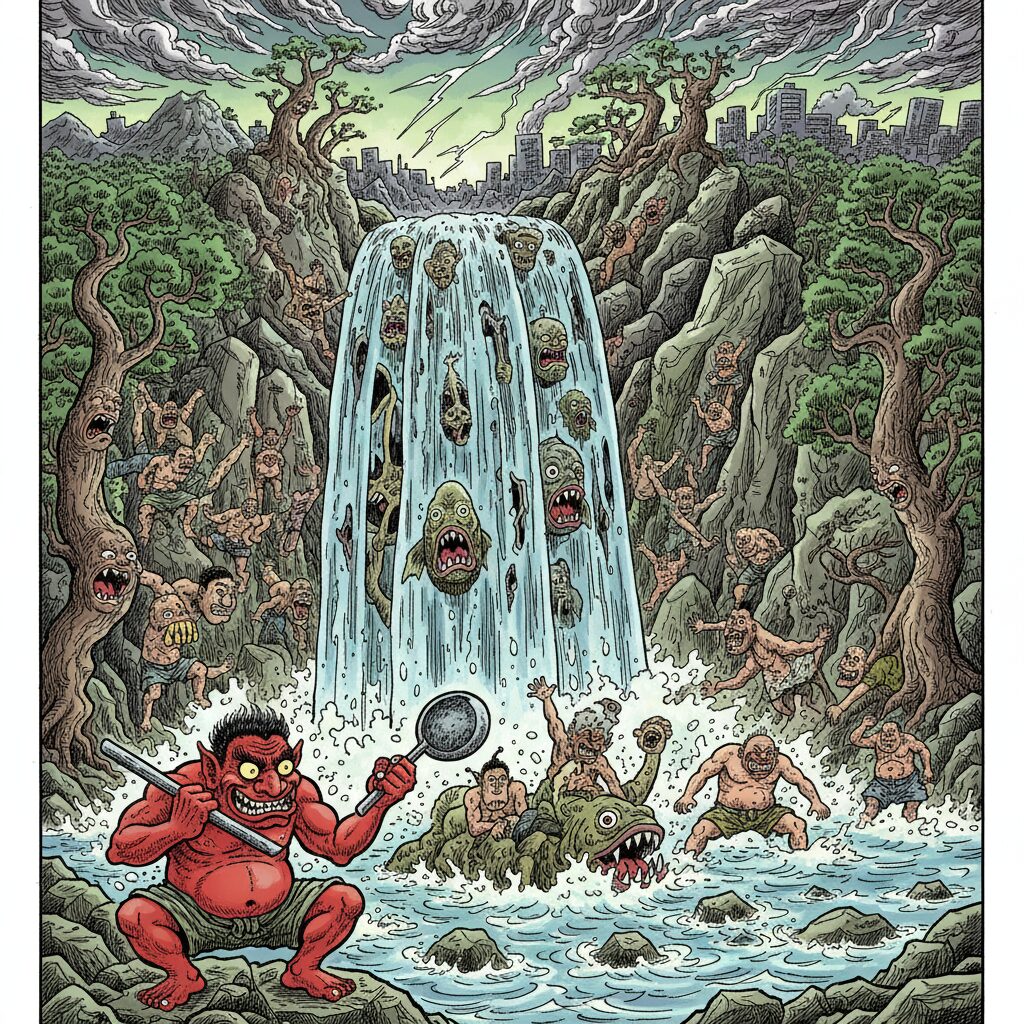
After about forty-five minutes of immersive walking, the journey along the Takimichi Trail reaches its breathtaking climax. The path curves around a final bend, the forest opens up, and there it stands: the Minoo Waterfall, a stunning column of white water plunging down a dark, sheer cliff face. The sight and sound are immediately invigorating, a powerful display of nature’s artistry that makes the entire trek worthwhile.
The First Glimpse and the Final Approach
The moment the waterfall comes into view is truly extraordinary. The distant hum you noticed earlier transforms into a thunderous roar that fills the air. The path widens into a spacious, open plaza, a natural amphitheater perfect for taking in this magnificent spectacle. The area around the base of the falls buzzes with activity. Benches are occupied by people gazing in awe, children point excitedly, and tripods are set up to capture the perfect long-exposure photograph. A couple of small teahouses and souvenir shops are tucked to the side, offering refreshments and a place to rest while enjoying the view. Despite the crowds, the overwhelming power of the waterfall creates a personal connection, as if it’s performing a private show just for you.
A Cascade of Beauty: Experiencing the Waterfall
The Minoo Waterfall, or Minoo-no-taki, plunges 33 meters in a single, graceful stream. Its name is said to come from its likeness to a traditional winnowing basket, known as a mi. The water crashes onto the rocks below with great force, sending a fine, cooling mist into the air that feels wonderfully refreshing on a warm day. The cliff face behind the falls is a tapestry of dark, rugged rock, often dotted with green moss and small ferns, providing a striking contrast to the brilliant white water. The pool at the base churns with turquoise and white, its energy the centerpiece of the entire scene. Standing before it, you feel a deep sense of humility and wonder. It’s a moment of pure, unfiltered nature that washes away the stresses of city life. This is the perfect culmination of the journey—a reward both visually stunning and emotionally moving. You’ll want to linger here, finding a spot on a bench or rock, simply watching the endless, hypnotic flow of the water.
A Journey Through the Seasons: Minoo’s Ever-Changing Canvas
Minoo Park is not a destination to visit just once; its character changes so profoundly with the seasons that every visit feels like an entirely new experience. The forest and waterfall display a unique palette each quarter, inviting visitors to return repeatedly to enjoy the complete spectrum of its beauty.
Spring’s Gentle Awakening (Sakura and Fresh Greenery)
Spring graces Minoo with a delicate touch. In late March and early April, clusters of wild cherry trees (Yamazakura) burst into bloom, their pale pink and white flowers creating a soft, ethereal contrast against the dark trunks. Unlike the manicured city parks, the sakura here feels wilder and more natural. Following the cherry blossoms, the entire valley bursts into a symphony of fresh green. The maple trees unfurl new leaves—a shade so vibrant and translucent it seems to glow from within. The air fills with the lively chirping of birds returning to the valley, and the increased snowmelt from the mountains energizes the Minoo River and waterfall with a powerful flow. Spring is a season of renewal, and a walk through the park feels like witnessing the world awakening from a long slumber.
Summer’s Lush Escape (Cooling Mists and Fireflies)
As the intense heat and humidity of Osakan summer take hold, Minoo Park becomes a vital urban refuge. A dense leaf canopy provides thick, protective shade, making the trail several degrees cooler than the city center. The forest is at its verdant peak, a deep, impenetrable green. The cicadas create a constant buzzing soundtrack, the quintessential sound of summer in Japan. Mist from the waterfall acts as a natural air conditioner, offering welcome relief to hikers on their journey. Perhaps the most magical part of summer is the evenings. In June, the park becomes a renowned spot for firefly viewing. At dusk, these tiny insects begin to glow, their gentle, blinking lights forming a fantastical, otherworldly spectacle along the riverbanks. It’s an unforgettable experience, like stepping into a fairytale.
Autumn’s Fiery Spectacle (The Famous Momiji)
If Minoo Park has a signature season, it is undoubtedly autumn. From mid-November to early December, the valley is set ablaze with color. During this time, the park’s extensive population of Japanese maple trees (momiji) delivers its world-famous display. The hillsides erupt in a breathtaking panorama of fiery reds, brilliant oranges, and vibrant yellows. The Takimichi Trail transforms into a corridor of color, with a canopy of crimson leaves overhead and a carpet of fallen leaves underfoot. This is the park’s busiest season, attracting visitors from across Japan and around the world who come to enjoy momijigari, the tradition of autumn leaf viewing. The air is crisp and cool, and the sight of the waterfall framed by bright red maple leaves is Minoo’s most iconic image. This is also the peak season for momiji tempura, and the sweet, fried aroma seems to linger in the air, completing the perfect autumnal sensory experience.
Winter’s Quiet Majesty (Crisp Air and Icy Accents)
After autumn’s fiery crescendo, winter brings a profound sense of peace and tranquility to Minoo Park. Crowds vanish, and the bare branches of deciduous trees form stark, beautiful silhouettes against the winter sky. The air grows cold and crisp, and the sounds of the river and waterfall carry farther, amplified by the silence. On the chilliest days, frost dusts the edges of leaves and rocks, transforming the landscape into a delicate, sparkling wonderland. Occasionally, a light snowfall blankets the park, creating a magical scene that turns the familiar trail into a completely new world. The park’s monkeys, present year-round, are often more visible in winter, their thick coats standing out against the muted surroundings. A winter walk in Minoo is a meditative experience, offering a chance to appreciate the forest’s fundamental structure and quiet beauty in its most restful state.
Practical Pilgrim’s Guide: Navigating Your Minoo Adventure
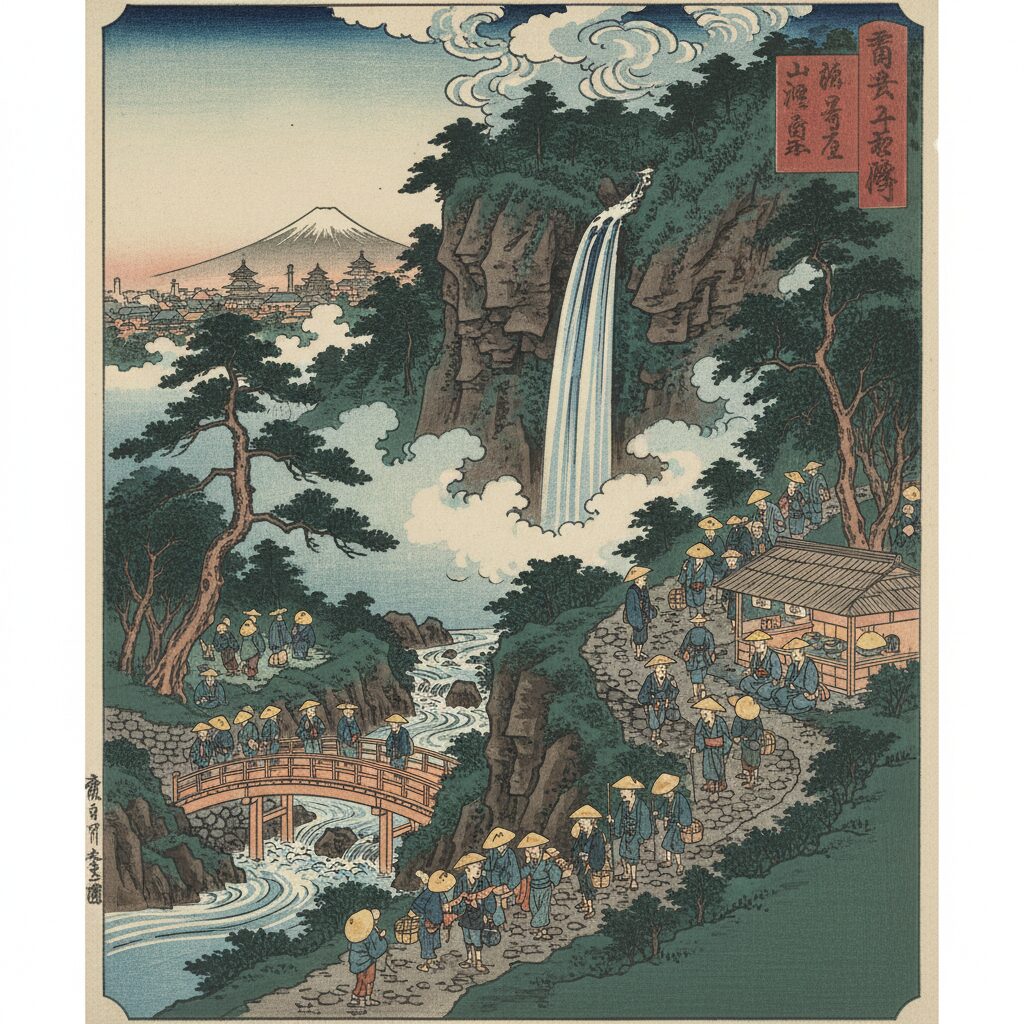
While the journey to Minoo offers an escape into nature, having a bit of practical knowledge can help make your adventure smooth, comfortable, and enjoyable. The park’s accessibility is one of its greatest strengths, but being familiar with the details beforehand will allow you to relax and fully immerse yourself in the experience.
Getting There: The Route from Osaka
Getting to Minoo Park is incredibly easy. The area is served by the Hankyu Railway, a private line recognized for its distinctive maroon trains. Starting from central Osaka, head to Hankyu Osaka-Umeda Station. It’s a large terminal, so look for signs directing you to the Takarazuka Line. Board a train bound for Takarazuka and disembark at Ishibashi handai-mae Station, just a few stops away. From there, transfer to the short, dedicated Hankyu Minoo Line, a small branch line that ends at Minoo Station. The entire journey takes around 25-30 minutes, offering a comfortable and scenic retreat from the city. This convenient route is a major reason Minoo is such a popular getaway for residents of Osaka.
Trail Tips and Essentials
Preparing for a day at Minoo is simple, but a few essentials will boost your comfort. First and foremost, wear comfortable walking shoes. Although the main Takimichi Trail is paved, it is a three-kilometer walk each way and will keep you on your feet for a few hours. Heavy-duty hiking boots aren’t necessary unless you plan to explore the more rugged, unpaved side trails branching into the mountains.
Bringing a water bottle is advisable, though you’ll find vending machines and teahouses along the way for refills. A camera is essential, as every turn reveals a fresh, photogenic scene. Carrying some cash is also smart, since many small trail-side stalls, especially those selling momiji tempura, may not accept credit cards.
The main trail is gentle and suitable for all ages and fitness levels. The round-trip hike to the waterfall typically takes about 90 minutes at a steady pace, but budgeting two to three hours allows plenty of time for photos, snacks, and simply enjoying the surroundings. For more adventurous hikers, maps at the park entrance highlight a network of more challenging trails leading to lookout points and deeper into the forested hills.
Local Etiquette and Considerations
Minoo Park is a treasured natural site, and visitors are asked to help maintain its pristine condition. Please follow the “leave no trace” principle and carry out everything you bring in. Rubbish bins are available near the entrance and the waterfall plaza—please use them responsibly.
One of the park’s most famous, and occasionally notorious, residents are the wild Japanese macaques. While spotting these monkeys can be exciting, it is vital not to feed or approach them. Feeding disrupts their natural behavior and can cause aggression. Keep a safe distance, store food securely in your bag, and observe them only from afar. Remember, they are wild animals deserving of respect and caution.
When visiting Ryuanji Temple or any other religious site in the park, please be respectful. Speak softly and be mindful of others who may be there to worship. By adhering to these simple guidelines, you can ensure a positive experience for yourself, fellow visitors, and the park’s delicate ecosystem.
A Breath of Fresh Air, A World Away
A trip to Minoo Park is more than just a day excursion from Osaka; it serves as a reminder of nature’s healing power and the remarkable harmony that exists between a sprawling megacity and its wild surroundings. The journey to the waterfall unfolds gently, narrated by a flowing river, ancient trees, and the changing seasons. It’s a place to walk, breathe, savor something unique, and marvel at a beauty that is both simple and profound. Standing in the cool mist of Minoo Waterfall, with its thunderous roar filling your ears, the neon lights and bustling streets of Osaka seem like they belong to another world. You leave not only with stunning photos but also with a sense of peace and renewal, carrying the fresh scent of the forest and the timeless rhythm of the water as you return to the city’s vibrant core.


